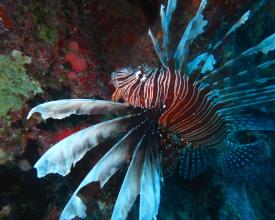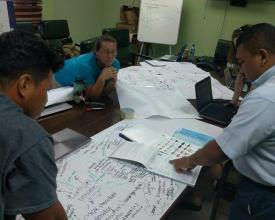
Building a market for invasive lionfish control

The Indo-Pacific lionfish is a major threat to Caribbean reefs. Blue Ventures is pioneering efforts to build Belize’s lionfish fishery, creating an economic incentive for the sustained removal of this invasive species while providing an alternative target for fishers and promoting associated cottage industries, reducing dependency on traditionally targeted fisheries. This effort is supported by an integrated lionfish control strategy, which helps to avoid unintended outcomes, and also details alternative targeted removal methods for sites where fishing is not permitted or practical.
Context
Challenges addressed
- Invasive lionfish
- Livelihood security
- Need for fisheries diversification
Invasive lionfish populations have a direct, negative impact on native fish biomass and will, in turn, be detrimental to traditional fisheries and the socio-economic well-being of fishing communities. Lionfish population suppression through targeted removals has been shown to protect reef fish populations. The impact of invasive lionfish on invertebrate populations and fisheries is as yet unassessed, though invertebrates constitute a large proportion of lionfish diets in Belize.
Current lionfish removal efforts are insufficient to effectively suppress populations. Fisheries diversification is needed due to the growing number of fishers and declining populations of commercially valuable species.
Location
Process
Summary of the process
By undertaking an extensive lionfish population assessment, and creating a lionfish management strategy that uses a coupled human and natural systems approach, informed decisions can be made to maximise benefits of lionfish control activities, as well as minimise unintended outcomes. Building awareness about the lionfish invasion catalyzes public interest in being involved in lionfish management. Buyers, exporters, importers and restaurants become more inclined to buy lionfish which in turn encourages fishers to catch it to meet demand. Fishers are then aware of a new target species they can access all year round to provide a more reliable income. By adding value via jewelry and processed products, lionfish will continue to be targeted and local businesses benefit from the increased income. Local women also learn new skills and gain a new source of income, boosting their household revenue.
Building Blocks
Adopt a Coupled Human And Natural Systems approach
The dynamics of human and natural systems are complex and characterized by reciprocal feedbacks that can interact across local and global scales. Successful natural resource management requires a better understanding of these coupled human and natural systems (CHANS), which must be incorporated at the planning stage. A CHANS approach involves both ecological and social concerns, and requires an interdisciplinary team to develop a conceptual framework of socioecological interactions (SEF), aiding all actors to consider potential outcomes from many different perspectives.
As a viable lionfish control programme will impact upon a wide range of stakeholders, it is crucial to develop a lionfish management strategy using a CHANS approach to maximize benefits and minimize unintended outcomes.
A population dynamics model that estimates lionfish population abundance, biomass and size structure under different management scenarios is central to lionfish management planning. Changes to all affected systems can then be interpreted qualitatively using the SEF.
Enabling factors
- Develop a conceptual framework of socioecological interactions (SEF) with representatives of all key stakeholders, informed by social research
- Create a lionfish taskforce that meets regularly to review progress and adapt management
- Estimates available for current status of lionfish density, size structure and catch rate (F), to feed into a population dynamics model
- Capacity or partnership with relevant experts to support SEF production and population dynamics modelling
Lesson learned
Due to the dynamic and interrelated nature of coupled human and natural systems, it may not be possible to foresee all consequences of different management activities at the outset. A good lionfish management strategy must therefore be flexible, with mechanisms enabling evaluation and adaptation.
Maximise input from a wide range of stakeholders, including but not limited to
-
authorities responsible for human development, environment, fisheries and indigenous peoples’ land rights
-
fishers associations
-
academic partners
-
private sector (seafood buyers, distributors, exporters, restaurateurs)
-
community representatives
-
protected area managers
-
NGOs working in the region
Estimate lionfish status and develop catch targets
Although eradication is no longer considered possible, lionfish population suppression allows native fish population recovery. With enormous variability in lionfish population density between reef locations, type and depth, a combination of commercial harvest, culling by SCUBA and deep-water traps is necessary to achieve the desired ecological outcomes.
In order to develop, implement and evaluate management interventions, it is essential to first determine the current status of lionfish populations. Due to their cryptic nature, the density of lionfish is often underestimated by traditional underwater visual census techniques; the Lionfish Focused Search method produces more accurate lionfish density estimates.
Coupled with prey fish population surveys, and following the method developed by Green et al. (2014: DOI 10.1890/13-0979.1), it is then possible to determine lionfish threshold densities – the site-specific density at which native fish populations can recover. This provides managers with a or management target, and the ability to calculate associated necessary catch target for each area to support long-term suppression.
Enabling factors
- Collaboration with government departments, relevant experts, dive centers and/or an active Lionfish Working Group
- Existing capacity or training provided for Lionfish Focussed Search (LFS) method, prey fish identification and use of R (https://www.r-project.org/)
- Extensive underwater surveys using the LFS m ethod to determine status of lionfish and prey fish populations
Lesson learned
Effective partnerships are vital. Without the involvement from stakeholders at all levels – including government departments, fishing communities, environmental organizations, tourist operators and academic experts – this process will not be successful. The involvement of relevant experts to provide training and/or determine site-specific lionfish threshold densities is needed.
Consistent, long-term monitoring using the LFS method is required to evaluate the impacts management interventions are having on lionfish populations.
Support emergent lionfish fishery
In areas that are accessible to fishers, commercial lionfish fishing presents the most feasible means to achieve lionfish removal at the frequency and high volume required to suppress populations.
Initially, fishers face a large opportunity cost in targeting lionfish over traditionally caught species due to the risk of a lionfish sting, which may cost a fisherman up to 24 hours of fishing time. This is exacerbated by an uncoordinated market and inconsistent demand, and in some cases a low willingness-to-pay for lionfish by consumers. Therefore, willingness-to-pay for lionfish must be higher than traditionally caught species. Restaurants also require access to a consistent supply of lionfish (and regular demand from customers) before including it on their menus.
Key actions:
- Safe-handling demonstrations for fishers provide practical training in
- adapting fishing techniques to target lionfish
- simple first aid for lionfish stings, overcoming concerns of envenomation
- Support to restaurants and seafood distributors seeking to purchase lionfish by linking fishers to buyers and offering marketing assistance through menu inserts and posters.
- A social marketing campaign targeted at consumers to increase demand and willingness-to-pay for lionfish
Enabling factors
- Safe-handling demonstrations so fishers are confident catching and handling lionfish
- Demand from local restaurants and/or local or export-oriented seafood distributors
- Creating a market chain between fishers and buyers – catalyzing fishers to target lionfish and enabling market growth
- Effective social marketing campaigns to increase demand for lionfish products
- High willingness-to-pay for lionfish: distribute materials to encourage lionfish consumption amongst customers
Lesson learned
Fishers face a large opportunity cost in targeting lionfish over traditionally caught species due to an uncoordinated market, inconsistent demand and low willingness-to-pay. This is exacerbated by lost fishing time of at least 24 hours in the event of an untreated lionfish sting. Therefore, willingness-to-pay for lionfish must be significantly higher than traditionally caught species. Restaurants require access to a consistent supply and have regular demand for lionfish before including lionfish on their menus. A central receiving station and distribution facility that consistently trades lionfish at a high price would provide the incentive for fishers to consistently target lionfish, as well as provide restaurants with the guarantee to include lionfish as a regular item on their menu.
Resources
Value-added lionfish products
Supporting women from fishing communities to create, market and sell jewelry made from previously discarded lionfish parts adds value to fishers’ lionfish catch. It also meets several needs simultaneously: poverty alleviation in fishing communities, gender equality as women learn skills and are supported to earn independently, and further awareness raising about invasive lionfish, thus contributing to the conservation of Belize’s marine ecosystem.
Other potential lionfish value-added product markets include lionfish burgers, frozen fillets for sale through supermarkets and animal feed. Further benefit to fishing communities could be achieved through establishing lionfish processing plants within the communities themselves, increasing the availability of skilled employment opportunities and providing new skills for local community members.
Enabling factors
- Jewelry training workshops for women from coastal fishing communities
- Business management and marketing support to lionfish jewelers
- Access to jewelry making kits and resources
- Access to discarded lionfish products such as spines and fins
- Access to markets to sell finished products
Lesson learned
Lionfish jewelry-making skills can be easily acquired and there is demand for the product. Belizean fishers' lionfish catch increases 13-40% in value when fins and spines are sold. Establishing the market-price for fins and spines is critical to ensure that this benefit is achieved. For that reason, jewelers should not be subsidized after initial training workshops. Jewelers from regions that do not have established markets for lionfish meat struggle to access lionfish parts; this can be overcome with a network of jewelers. A network also fosters knowledge-sharing, accessing diverse sales points, developing brand and business plan, and ultimately accessing international markets. Through targeting women from coastal fishing communities, household incomes are diversified and women are empowered. Further, lionfish jewelry can enhance lionfish outreach and jewelers themselves become advocates for the cause, driving behavior change towards increased lionfish exploitation.
Implement an awareness raising campaign
In order to establish a commercial lionfish market, it is important to understand the perceptions of stakeholders (particularly fishers and restaurant owners) and the general public towards catching and eating lionfish. For example, in a survey of the general public undertaken in Belize in 2015, around half of respondents who had not eaten lionfish stated that they would not try a free sample because they believed it to be dangerous. Furthermore, lionfish exploitation was significantly associated with knowledge about the invasion.
Once the barriers and misconceptions around catching/eating lionfish have been identified, they can be resolved by developing a targeted outreach programme with the general public and social marketing campaign targeting restaurants and consumers that informs people about the lionfish invasion in a way that reflects local concerns and values.
Activities may include:
- cooking demonstrations
- educational presentations
- lionfish tasting events (held in partnership with local restaurants/cooks)
- safe-handling workshops
- interactive, educational booths with lionfish tasters
Enabling factors
Specialized surveys with particular groups:
- interviews with fishers to understand barriers to lionfish fishing, including the economic viability of lionfish markets compared to traditional fisheries markets
- questionnaires with restaurant owners / seafood suppliers to identify attitudes about lionfish and barriers to increased lionfish exploitation
- surveys amongst the general public to assess their knowledge about the invasion, and their perceptions of lionfish as a seafood dish
Lesson learned
To reach a wide range of audiences, awareness raising activities can be held at many different kinds of events including food festivals, lionfish tournaments, and with schools, restaurants and recreational dive tours.
Safe-handling workshops are ideally carried out as a knowledge exchange, led by a fisher or fishers already engaged in lionfish fishing.
Lionfish control in areas inaccessible to fishers
Where commercial lionfish harvesting is not practical or permitted (such as in protected areas), or if the current fishing pressure is not sufficient to suppress lionfish populations below site-specific management targets, a combination of alternative removal methods can be used to reduce lionfish populations, including:
-
culling by SCUBA, either by protected area managers or dive operators
-
lionfish culling competitions (also known as derbies or tournaments)
-
deep-water traps, whilst still at the design stage, have the potential to be used as a tool within a package of lionfish management actions
Multiple stakeholders may need to conduct one or more of these activities at a given site to achieve a desired level of lionfish suppression.
Enabling factors
- Lionfish management targets must already be known so that ineffectively controlled sites can be identified
- A lionfish task force must be active so that sites are prioritised for management based on best available knowledge
- Culling by SCUBA requires an active and informed diving industry, as well as capacity for adequate management and enforcement of regulations (e.g. to prevent divers from targeting other species while carrying out lionfish culls)
Lesson learned
- Given the widespread nature of the lionfish invasion and limited resources, it is unlikely that lionfish populations can be controlled in all areas of conservation importance. Therefore, sites for management should be prioritised via a a lionfish taskforce, in consultation with communities and stakeholders.
- Culling can cause reef damage if not properly managed: inexperienced divers may damage corals with spears, or special permission for lionfish culling can make enforcement of otherwise prohibited activities difficult (e.g. spearfishing within protected areas). These challenges must be addressed before implementing any programme.
- Lionfish tournaments do not provide regular enough removals to sustain lionfish population suppression if not coupled with additional strategies. They do however provide an excellent opportunity for awareness raising.
- Risk of traps causing physical damage to reefs or catching by-catch must be eliminated before traps are introduced.
Impacts
Lionfish Fishery
In 2010, no restaurant served lionfish. In 2015, 9% of Belize's restaurants reported serving lionfish, and purchased the equivalent of 30,000 lionfish from fishers, either whole or as fillet. The price for lionfish through this market increased by 50% over four years (2013-17).
Blue Ventures and the Sarteneja Fishermen Association (SFA) have both been actively involved in engaging consumers, fishers and restaurants in Sarteneja with the benefits of fishing and eating lionfish. 77% of Sartenejan fishers interviewed in 2016 reported selling lionfish in 2016.
Lionfish Jewelry
In 2014, a jeweler from southern Belize began making lionfish jewelry in 2014, purchasing 5,000 tails from fishers annually. This collection accounts for 25% of her sales. In 2015, Blue Ventures and SFA established a women's group (Belioness), with membership from seven coastal communities. Both sell lionfish jewelry locally and overseas.
The purchase of each tail adds 13-40% to the sale price of lionfish for fishers.
Lionfish Status
Lionfish density in Belize peaked in 2011 (159 fish/ha), decreasing to 10 fish/ha in 2015. Highest densities found in areas inaccessible to fishers (No Take Zones). In 2015, 78% of surveyed sites were found to be effectively controlled.
Beneficiaries
Fishers and seafood industry, local community members especially women, and tourism.
Sustainable Development Goals
Story

Estrellas Del Mar, affably referred to as “Pablito’s” by all who frequent it, has become a pillar in the Sarteneja lionfish market. As a consistent buyer, their reliability as a sales point for fishers has been critical to helping entrench the viability of the lionfish fishery at the community level. Facing a large opportunity cost in targeting lionfish, fishermen have benefitted immensely from Pablitos’ ability to market this product to Belizeans and tourists alike. As a direct result of Blue Ventures’ regular workshops and taster events in Sarteneja, in 2013 Pablito and his wife Aracely began serving lionfish in their restaurant, prepared in diverse ways; flautas, empanadas, ceviche, empanisado. Although an unconventional couple in a conservative village, Pablito and Aracely have overcome many hardships to own one of the most popular restaurants in the community. Building on extreme personal adversity, their perseverance and adaptive nature have guided them through the years, from supplying chicken to Sarteneja retail outlets, to undertaking garbage collection. Their resiliency has molded them into a keen entrepreneurial couple, quick to recognize and seize a profitable opportunity. They rose again to establish their restaurant 13 years ago. In 2011, Pablito’s was selected by Blue Ventures as the venue for its first lionfish preparation workshop. Lionfish is now Pablito’s most popular dish, proudly standing at the top of his menu and hand-painted on his restaurant’s display. Assisted by Blue Ventures’ social marketing campaign, Pablito’s modest but noteworthy online presence has sent curious tourists and visitors his way. It is this final transition that has supported Pablito’s tenacity to provide for his family and support the education of his three daughters. With a 15 year old daughter to support through junior college and university, Pablito envisions the growing volume of tourists, and their appetite for lionfish, as an essential component to her higher education.













